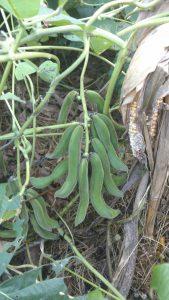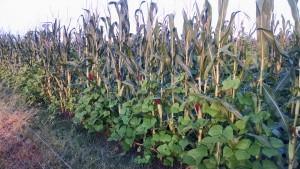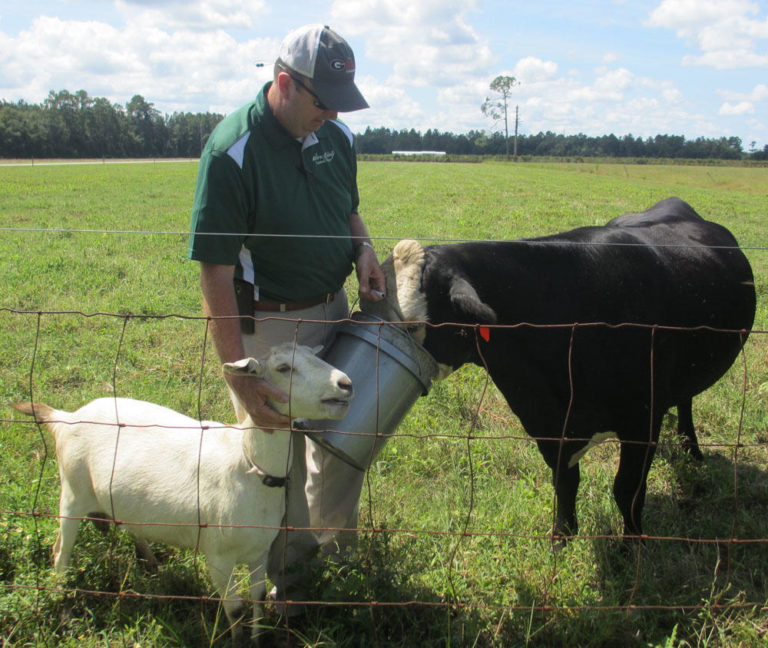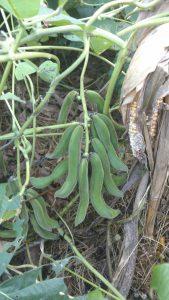MANOR, Georgia – Motorists passing through rural Manor, GA along Highway 122, perhaps on their way to Waycross, were puzzled by the mystery crop growing on a portion of Lynn Barber’s Heritage Acres farm.
“Some of the older farmers knew exactly what it was, but a lot of people were stopping to ask me if I was growing kudzu,” laughs the young livestock farmer.
Through a Southern Sustainable Agriculture Research & Education (SSARE) Producer Grant, Barber is reviving a crop not regularly seen in the state as grazing forage since World War II.
For the past two years, Barber has been grazing his small herd of Angus/Hereford cross cattle on velvet bean with standing corn as an alternative to hay supplementation in the winter.
“I first got the idea for this project after talking with several people who grew up on farms prior to World War II,” said Barber. “These men indicated that grazing corn and velvet beans was a regular part of the farming operations in the South at that time.”
Barber admits that prior to the SSARE project, he had never seen velvet bean. And given the reaction from others who drove past his 3-acre test plot, they didn’t know what they were looking at either.
The summer legume, which looks a lot like the invasive trailing kudzu vine, produces giant bean pods about 8 inches long and vines up to 15 feet in length. It was a popular forage crop in the early 1900s in many Southern states because of its high protein content. At one point, Georgia was producing over 1 million acres of velvet bean. Velvet bean fell out of popularity after the last World War.
For Barber, who manages 15 acres of his family’s 100-year-old, 100-acre farm, he felt the older production method would be ideal for small farmers, like himself, who lack the time, labor and feed storage capacity for hay. He farms only part-time, holding down a full-time job as a Career, Technical and Agricultural Education Director for the Ware County school system.
In the SSARE project (FS14-278), “Grazing Standing Corn and Climbing Beans,” Barber interplanted velvet bean with corn in April and strip grazed ten head of beef cattle along with several goats beginning in November. Each week, the strip wire was moved every 10 yards, allowing the animals to graze until February. The velvet bean provided protein, while the standing corn provided energy, as well as a substrate for the beans to climb on.
Barber sought the assistance of the University of Georgia Cooperative Extension System in his efforts. The UGA seed lab donated some velvet bean seed for the project.
“I found that by grazing the corn and beans, my labor was decreased during November and December. Grazing the corn and beans reduced the amount of hay fed during this time, probably by half, and no supplementation was given until nearly the end of December,” said Barber. “I would estimate that 1 to 2 hours per week were saved during this time. Plus the cattle body condition was maintained and the expense of wintering my cattle held steady.”
Barber believes that the velvet bean also provided additional benefits of adding nitrogen to the soil, controlling weeds, suppressing pests and breaking up compaction.
“I’m happy with the way the project turned out,” said Barber. “I’d definitely grow velvet bean again as a forage option, but I’m seeking additional land so as not to inhibit summer grazing by taking my current acres out of production.”
Barber is playing around with other forage mixtures, such as millet, and fall brassicas like turnips and radishes.
Heritage Acres farm started out in tobacco, livestock and row crops. The farm remains diversified today, with some livestock and timber production and the remaining acres leased out for vegetables like bell peppers and squash.
Barber hopes to acquire more property from the family and add to his cattle herd, maybe also a few more goats and some feeder pigs. As a small farmer, he sees intensive grazing as the best way to manage that growth sustainably.
“In New Zealand the farmers call themselves grass farmers, not livestock farmers. They use the forage to complement the livestock,” said Barber. “That’s kind of my goal, to focus on the forage. You’ve got to have the feed and manage it right for the cattle to work for you.”
Barber’s use of velvet bean in his grazing program has caught the eye of neighboring farmers, who have indicated they want to try the grazing scenario with their own herds.
Cooperators on the project include: Joe Slusher, UGA Cooperative Extension; John Allen Bailey, Georgia Young Farmers Association; and Tommy Waldrop, Georgia Agriculture Education.
Published by the Southern Region of the Sustainable Agriculture Research and Education (SARE) program. Funded by the USDA National Institute of Food and Agriculture (NIFA), Southern SARE operates under cooperative agreements with the University of Georgia, Fort Valley State University, and the Kerr Center for Sustainable Agriculture to offer competitive grants to advance sustainable agriculture in America's Southern region. This material is based upon work that is supported by the National Institute of Food and Agriculture, U.S. Department of Agriculture, through Southern Sustainable Agriculture Research and Education, under sub-award numbers FS14-278. USDA is an equal opportunity employer and service provider. Any opinions, findings, conclusions, or recommendations expressed in this publication are those of the author(s) and do not necessarily reflect the view of the U.S. Department of Agriculture.
View Related SARE Grant:
- Grazing Standing Corn and Climbing Beans (FS14-278)



